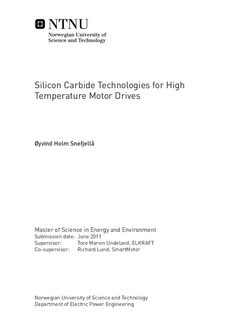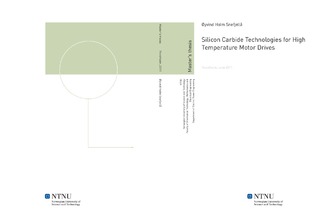| dc.description.abstract | Many applications benefit from using converters which can operate at high temperatures among them; down-hole drilling, hybrid vehicles and space craft. The theoretical performance of transistors made of Silicon Carbide (SiC) is investigated in this work. It is shown that their properties at high temperatures are superior compared to Silicon (Si) devices. Two half-bridge converters, using SiC normally-off Junction Field Effect Transistors (JFET) and SiC Bipolar Junction Transistors (BJT), are designed and tested to verify the performance of SiC devices. The challenges which arise when replacing slow switching Si devices with extremely fast SiC transistors are thoroughly discussed. To fully utilize the properties of SiC transistors, the converter designer must pay extra attention to the Printed Circuit Board (PCB) layout and component selection. For best device performance, all parasitics should be kept at a minimum. A high value of the Schottky diode capacitance results in voltage and current ringings, thus more ElectroMagnetic Interference (EMI) and switching energy loss. It is recommended selecting a Schottky diode with low junction capacitance as the freewheeling diode of the converter. Simulations and measurements show that the SiC transistors require special gate driving circuits to perform at their best. It is recommended to use a two-stage driver with high capability of charging and sinking gate/base currents. The JFET driver should also have a bipolar output to provide high noise immunity. The JFET is classified as a unipolar device; however the nature of the gate-source structure, which is a pn-junction, gives the device some bipolar characteristics. The gate structure is similar to BJT. To obtain a low on-state resistance some continuous gate current has to be provided. This is more pronounced at high temperatures.An analog control board, for operating the half-bridge as a step down converter, is designed and implemented. The controller uses current mode control to obtain a constant output voltage. Slope compensation is included to ensure stable operation at high duty-cycles. This makes the converter able to operate stably for a wide range of input voltages. The step down converter shows excellent performance during stationary operations and the ripple voltage is within its limit. When operating at high ambient temperatures it is important to have small transistor losses to minimize the self-heating of devices. The losses of a three phase inverter are calculated based on the measured conduction and switching losses of the SiC transistors. The calculations show that both inverters, based on BJTs and JFETs, are able to operate with very high efficiency even at high temperatures. High temperature characterization of the devices shows that their dynamic behavior, i.e. switching losses and switching times, are almost unaffected by temperature changes. The transistors, tested in this work, are suited to operate at ambient temperatures up to 150 ˚C. This is imposed by the conventional device packaging. Higher operating temperatures are achievable by using different packaging technologies, i.e. metal packaging advanced soldering methods. | nb_NO |

